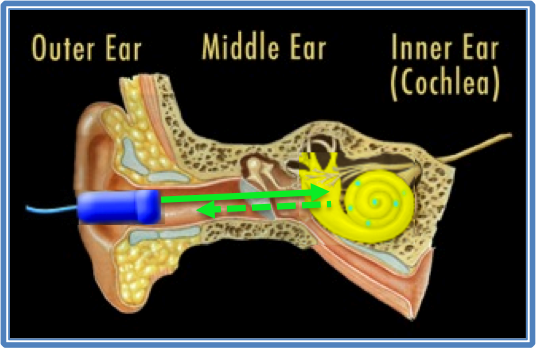Understand Basic Ear Anatomy and the OAE Screening Process
A good way to get the "big picture" of the screening and follow-up protocol is to visualize the steps as a flowchart. 
A more detailed understanding of the protocol as it relates to basic ear anatomy can also be helpful. The graphic illustrations below show how the OAE probe is sending a signal into the ear and the ear's response under a variety of conditions.
If you get a PASS on the OAE screening, it means that the sound stimulus traveled from the probe to the inner ear and that the inner ear responded by sending an otoacoustic emission (OAE) back to the probe.

Screening is complete for that ear.
If an ear does NOT PASS, further investigation is needed:
- SCREEN again (OAE 2) in two weeks in case the first result was due to screener error or a temporary condition (like a head cold).
If the ear still does NOT PASS:
- REFER the child to a Health Care Provider who can check whether a common problem, such as blockage in the outer ear or fluid in the middle ear (otitis media) is present. These conditions may block the sound stimulus from reaching the inner ear or the OAE response from returning to the probe. Medication or treatment may be necessary.

- RESCREEN (OAE 3) the ear after medical clearance.
If the ear still does NOT PASS:
- REFER the child to a pediatric audiologist who can evaluate whether the inner ear is functioning or whether a permanent hearing loss is present.

The OAE screening and follow-up process is COMPLETE ONLY when:
- Both ears PASS the screening, or
- An AUDIOLOGICAL EVALUATION has been completed and you have received the diagnostic results.
For a printed copy of the information above, and for more detailed directions on the "next step" for any individual child not passing the screening, view the Recommended OAE Screening Protocol.
|
Let us know if you have any questions about the basics of the OAE screening process and protocol:
echo.ncham@usu.edu
And, as always, share www.KidsHearing.org with anyone you think would benefit from our resources.
|